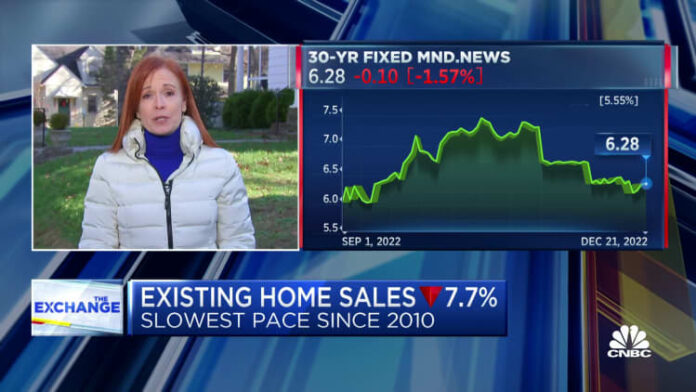Existing home sales were down 7.7% in November from October, according to the National Association of Realtors.
The seasonally adjusted annualized pace was 4.09 million units. That’s weaker than the 4.17 million units forecast by housing analysts, and it was a much sharper drop than the usual monthly declines.
Sales fell 35.4% year over year, marking the tenth consecutive month of declines. That was the weakest pace since November 2010, except for May 2020, when sales fell sharply, albeit briefly, in the early days of the Covid pandemic. In November 2010, the nation was mired in the Great Recession and a foreclosure crisis.
Those numbers are based on deals, so the deals were likely signed in September and October, when mortgage rates last peaked, before falling slightly last month. Interest rates are now about a percentage point lower than at the end of October, but still a little more than double what they were at the beginning of this year.
lane turner | The Boston Globe | Getty Images
“Essentially, the housing market was frozen in November, similar to the selling activity seen during the Covid-19 economic lockdown of 2020,” said Lawrence Yun, NAR’s chief economist. “The main factor has been the rapid rise in mortgage rates, which hurt housing affordability and reduced the incentives for homeowners to list their homes. Also, the available housing stock remains near historic lows.”
Continue reading: Demand for mortgage refinancing surged 6% last week
There were 1.14 million homes for sale at the end of November, up 2.7% from November last year, but at the current pace of sales, that’s still a low 3.3 months of supply.
Low supply kept prices higher than a year ago, rising 3.5% to a median selling price of $370,700, but those annual gains are shrinking fast and are well below the double-digit gains posted earlier this year. It’s still the highest November price real estate agents have ever recorded, and at 129 straight months, it’s the longest-running streak of year-over-year price gains since real estate agents began tracking it in 1968. About 23% of the houses were sold above list price due to tight supply.
“We’ve seen house prices fall from their summer highs over the past five months. At the same time, we’ve also seen rental growth decline for 10 consecutive months,” wrote George Ratiu, senior economist at Realtor.com, in a press release. “However, the cost of real estate remains a challenge for many households looking for a home, particularly as high inflation and still high interest rates have eroded purchasing power.”
Sales fell in all regions, but most sharply in the west, where prices are highest, by almost 46% year-on-year.
Homes stayed on the market longer in November, an average of 24 days, versus 21 days in October and 18 days in November 2021. Despite the slower market, 61% of homes were signed in less than a month.
With prices still elevated and mortgage rates hitting a cyclical peak, first-time buyers were left on the sidelines. They accounted for 28% of sales in November, flat from October, up slightly from 26% in November 2021. Historically, first-time buyers make up about 40% of the market. A separate survey of real estate agents put the annual rate at 26%, the lowest on record.
Sales fell across all price points, but saw the sharpest drop in the $1 million-plus luxury category, down 41% year over year. This sector had reaped the greatest gains in the early years of the pandemic.
Mortgage rates have fallen from their recent highs, but it remains to be seen whether this will be enough to offset higher prices.
“The market may be thawing as mortgage rates have fallen for five consecutive weeks,” Yun added. “The average monthly mortgage payment is now almost $200 less than it was a few weeks ago when interest rates were at their peak this year.”
















